Burp Suite DAST (former Burp Suite Enterprise) alternative : Escape DAST
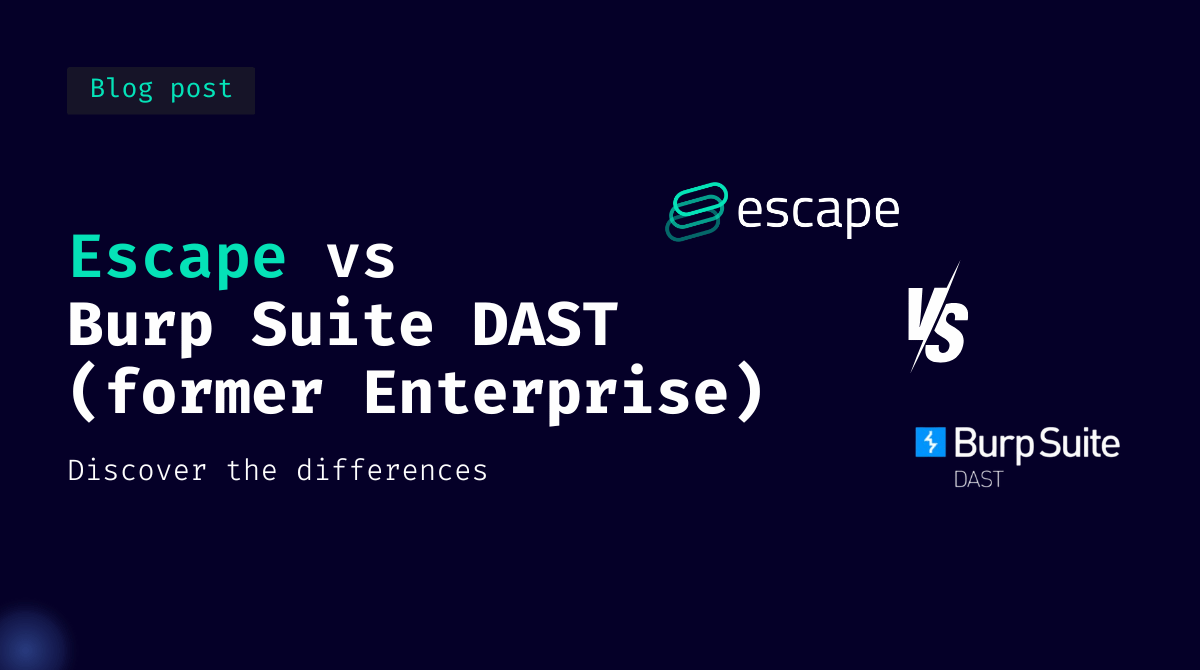
Finding the right tools for your AppSec team can be a daunting task. Especially when it comes to testing modern applications like SPAs, APIs, and Microservices. Today, attackers prioritize exploiting an application's business logic flaws and truly understanding the underlying logic is challenging for most DAST tools without excessive tweaking.
Both Burp Suite DAST (formerly Burp Suite Enterprise) and Escape offer solutions tailored to application discovery and DAST (Dynamic Application Security Testing) scanning workflows, but their approaches differ.
This comparison aims to help you navigate these differences, highlighting how each tool supports your journey from application discovery to remediation.
TL;DR: How Escape DAST compares to Burp Suite DAST (former Burp Suite Enterprise)
Escape and Burp Suite DAST cater to different needs, whether you're pentesting a single application, scaling across large teams, or automating security testing in CI/CD.
We've built this comparison based on the following sources:
- Official websites
- Demos on YouTube and official documentation
- Feedback from security professionals (whether Burp Suite's and Escape's current customers or not)
Burp Suite DAST
Pros
✅ Highly customizable with manual control for fine-tuning scans and handling complex scenarios
✅ Extensive support for a wide range of authentication methods
✅ Backed by Burp Suite's ecosystem and community
✅ Supports a large variety of plugins, both free and paid, allowing you to extend its capabilities beyond the out-of-the-box features
Cons
❌ Steep learning curve for beginners due to its complex interface and manual configuration
❌ Resource-intensive; may not perform well on low-end systems during large scans
❌ Less straightforward setup for API scanning: API specifications must be uploaded manually to start security testing
❌ Does not fully automate the detection of business logic vulnerabilities
❌ Lack of code owner identification
❌ Offers detailed remediation guidance but no code-level fix suggestions
Escape
Pros
✅ Easy setup: Complex authentication handling & automated API documentation generation that helps you to launch scans right away and reduces the need for maintenance of scans
✅ Custom security tests that do not require maintenance
✅ Business logic testing: finds IDORs, SSRFs and Access control issues in modern web applications
✅ Actionable remediation code snippets for developers tailored to their frameworks
✅ Integrations with advanced tools like Wiz
✅ In-depth application discovery, including internal API discovery from code
Cons
❌ Escape DAST’s plugin or extension ecosystem might not be as extensive as Burp Suite’s, potentially limiting its extensibility and integration with third-party applications.
❌ Advanced feature sets require specialized knowledge
In-depth feature comparison between Burp Suite DAST and Escape DAST
Complexity of scan setup
Burp Suite DAST: For web applications, Burp Suite offers automated scanning that can crawl and identify vulnerabilities, but for API scans, it requires more manual setup (see Burp Suite docs). Users must upload API definitions such as OpenAPI, Swagger, Postman Collections, or SOAP WSDL, either via URL or file upload. Once the schema is uploaded, Burp validates it and identifies API endpoints for scanning, but users must manually configure the scan settings. This adds complexity to API scanning as the setup process isn't fully automated and requires intervention to ensure the scan is accurate.

Escape: Offers automated scan setup for web applications and for APIs with API schema generation (learn more about it here).

Once generated, API schemas are seamlessly integrated into the DAST process, eliminating the need for manual effort associated with uploading specifications. Users can initiate dynamic application security testing with a simple click, employing the latest schema versions to ensure thorough and accurate testing coverage.
Depth of algorithm findings
Burp Suite DAST: Burp Suite is known for its deep and thorough vulnerability analysis, especially for web applications. It employs a combination of automated and manual testing techniques to identify a wide range of vulnerabilities. Burp Suite uses a crawling algorithm powered by their security research that can detect hidden endpoints, session handling issues, and authentication flaws. However, some of its deeper findings require manual interaction, as Burp allows users to fine-tune scans, review traffic, and inspect how specific vulnerabilities manifest. The depth of the findings is enriched by manual testing capabilities, making Burp useful for experienced penetration testers. For teams that want to ensure automation and depth of findings at scale without manual assistance, it might not be a viable solution.
I could mention is that we are kind of not super happy with the quality of the findings in Burp Suite. It's not just the false positives, but generally even if it's a true positive, usually it's relatively low-impact things that you can detect.. - Product Security Lead at Global Delivery app service
- Escape: Advanced detection algorithms identify a broader range of vulnerabilities, including complex business logic flaws like IDORs, SSRFs, and Access control issues in modern web applications. For all modern applications, Escape handles testing them natively.
- You can learn more about Escape's proprietary business logic testing algorithm here.
- And about Escape's DAST web application crawling algorithm here.
How Escape DAST enabled deeper business logic testing for Arkose Labs
Authentication
Burp Suite DAST offers highly customizable authentication handling, making it suitable for both simple and complex authentication workflows. It supports a wide range of authentication methods, including form-based login, Basic Auth, JWT, session cookies, login recording, and more. Users can also manually configure authentication settings. For more advanced use cases, Burp also supports MFA, though it requires manual intervention or custom configurations to handle MFA effectively. Burp Suite’s authenticated crawling and scanning feature allows for the testing of both unauthenticated and authenticated parts of an application.
Escape DAST, on the other hand, emphasizes automation in the authentication setup. It supports various mechanisms, including form-based login, API tokens, JWT, or presets like Browser Automation Preset, using Playwright for browser automation actions. It is designed for simpler, less manual setups and more automated configurations. Once authentication details are provided, Escape DAST can automatically manage sessions and tokens during the scan, reducing the need for manual intervention. This makes it particularly suited for CI/CD environments, where ease of integration and automation are key.
Custom security tests
Both Escape and Burp Suite offer solutions for custom security tests. On Escape's side, this feature is called "Escape rules," while on Burp Suite's side, it's called "BChecks."
While bChecks and Escape custom tests are pretty similar on the surface, bChecks use a more verbose language, less structured like the YAML operators (detectors/transformations) that Escape uses. The biggest difference is also in the feedback-driven exploration engine and the scalar inference system that is built into Escape, helping you cover all the routes with confidence and abstractions of data manipulated and easily available through Custom Tests.
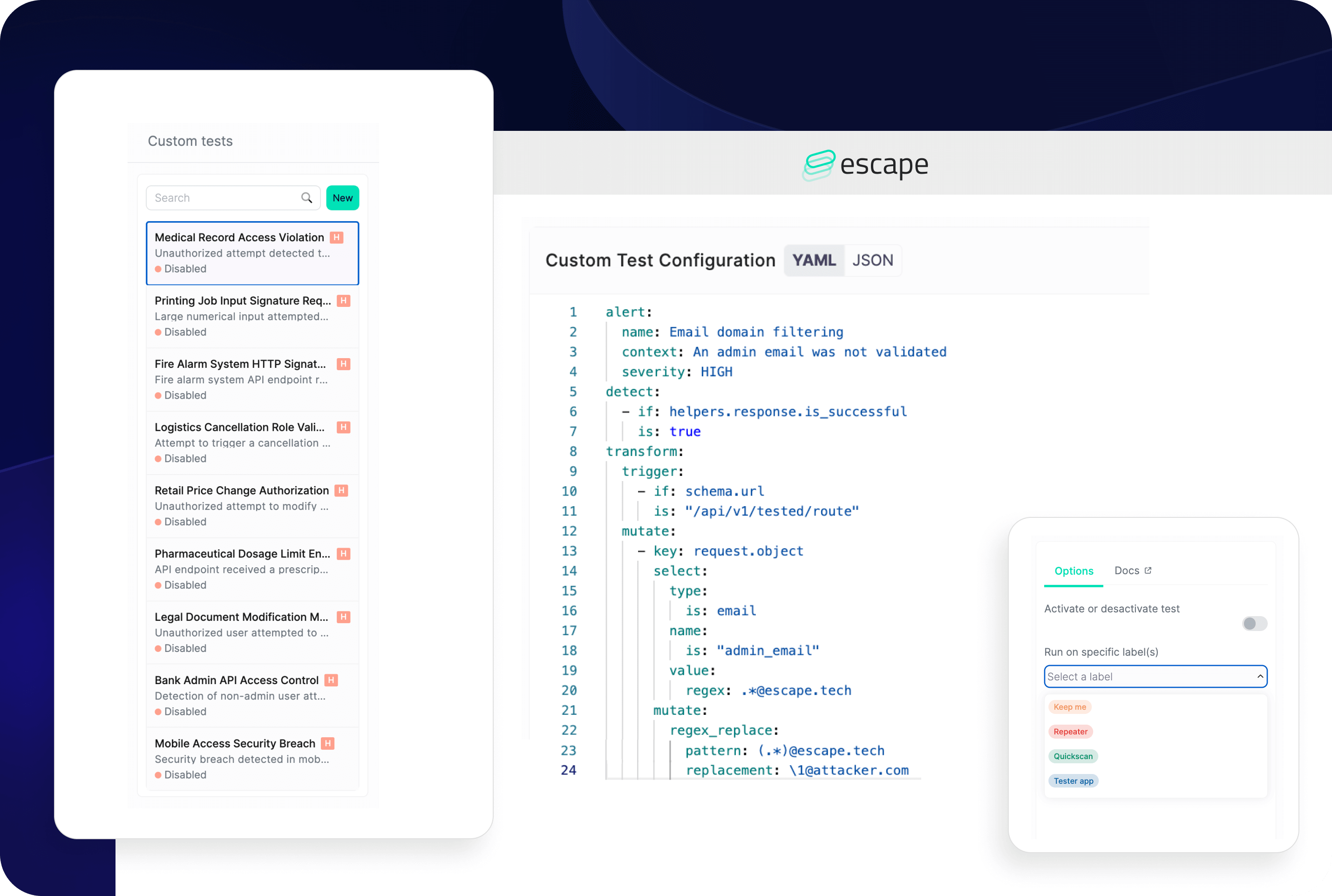
GraphQL API support
GraphQL, a query language for APIs, has gained significant traction in recent years due to its flexibility and efficiency. Escape DAST has exceptional support for GraphQL Security Testing, leveraging its membership in the GraphQL foundation and international recognition for its research in this domain.
On the other hand, according to their website, Burp Suite DAST's GraphQL crawls rely on introspection. Or you can manually interact with GraphQL APIs, for example, using Burp's extension for GraphQL (such as GraphQL Intruder or Burp Suite extensions from the BApp Store) to improve its capabilities.
Remediations
Burp Suite DAST: provides generic remediation information without offering tailored code snippets
Escape: provides remediation code snippets, tailored to each development framework, helping developers fix issues directly in the code.
CI/CD Integration
Both Burp Suite DAST and Escape provide integration with major CI/CD providers. Escape offers a native CI integration package compatible with GitHub Actions, streamlining the integration of security testing into the development workflow.
Jira integration
Efficient collaboration and issue tracking are essential for effective vulnerability management. Both Escape and Burp Suite Enteprise provide seamless native integration with the Jira ticketing system, facilitating streamlined communication and issue resolution.
Up-to-date API Inventory, and continuous application discovery
Maintaining an up-to-date inventory of APIs and web apps, and proactively identifying newly exposed vulnerable applications is usually an important part of your AppSec strategy.
Escape provides in-depth application discovery from multiple sources:
- Agentless discovery of externally exposed applications through a combination of different techniques
- API discovery from source code
- Escape Inventory also ingests data from various types of integrations to enhance the quality of the results like API gateways (Apigee, Kong Gateway, Kong Konnect) or Developer tools like Postman (a complete list can be found here)
Escape uses AI-powered fingerprinting to also classify applications by analyzing various characteristics, including structure, endpoints, and response patterns. This AI-based approach enables high-accuracy detection and categorization of various application types, even for unique or non-standard configurations.
Additionally, Escape reconstructs API schemas by parsing the Abstract Syntax Tree (AST) of both frontend and backend source code.
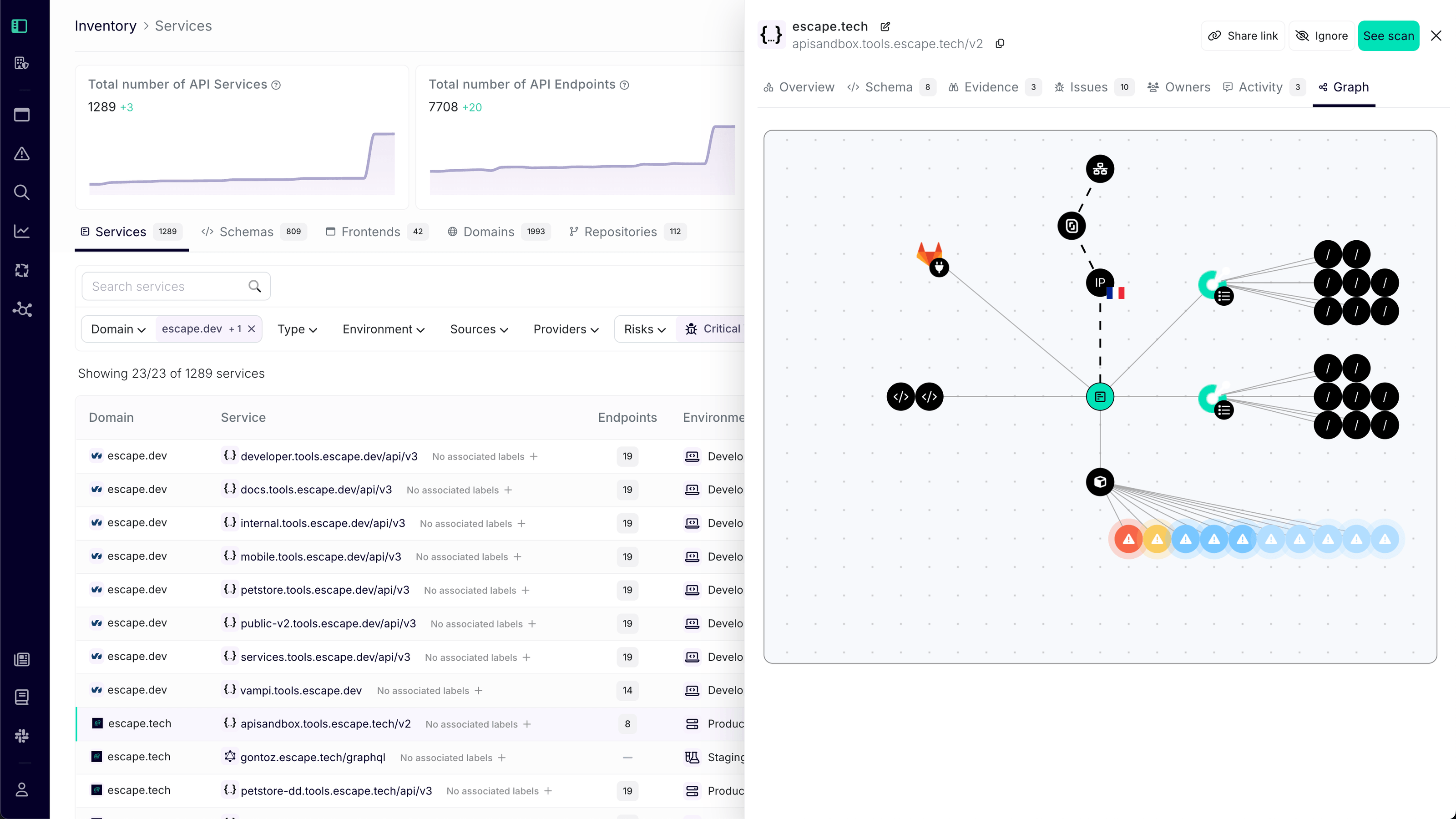
On the other hand, while Burp Suite Enterprise offers automated content discovery within web applications, it lacks dedicated API catalog capabilities. As a result, users may encounter challenges in comprehensively discovering and managing APIs within their applications.
You can benefit from the Sites page in Burp Suite DAST that contains a list of sites that you have configured, which each represents a website or web application that you want to scan and track, but it doesn't show you much of the interaction of this site with any specific environment:
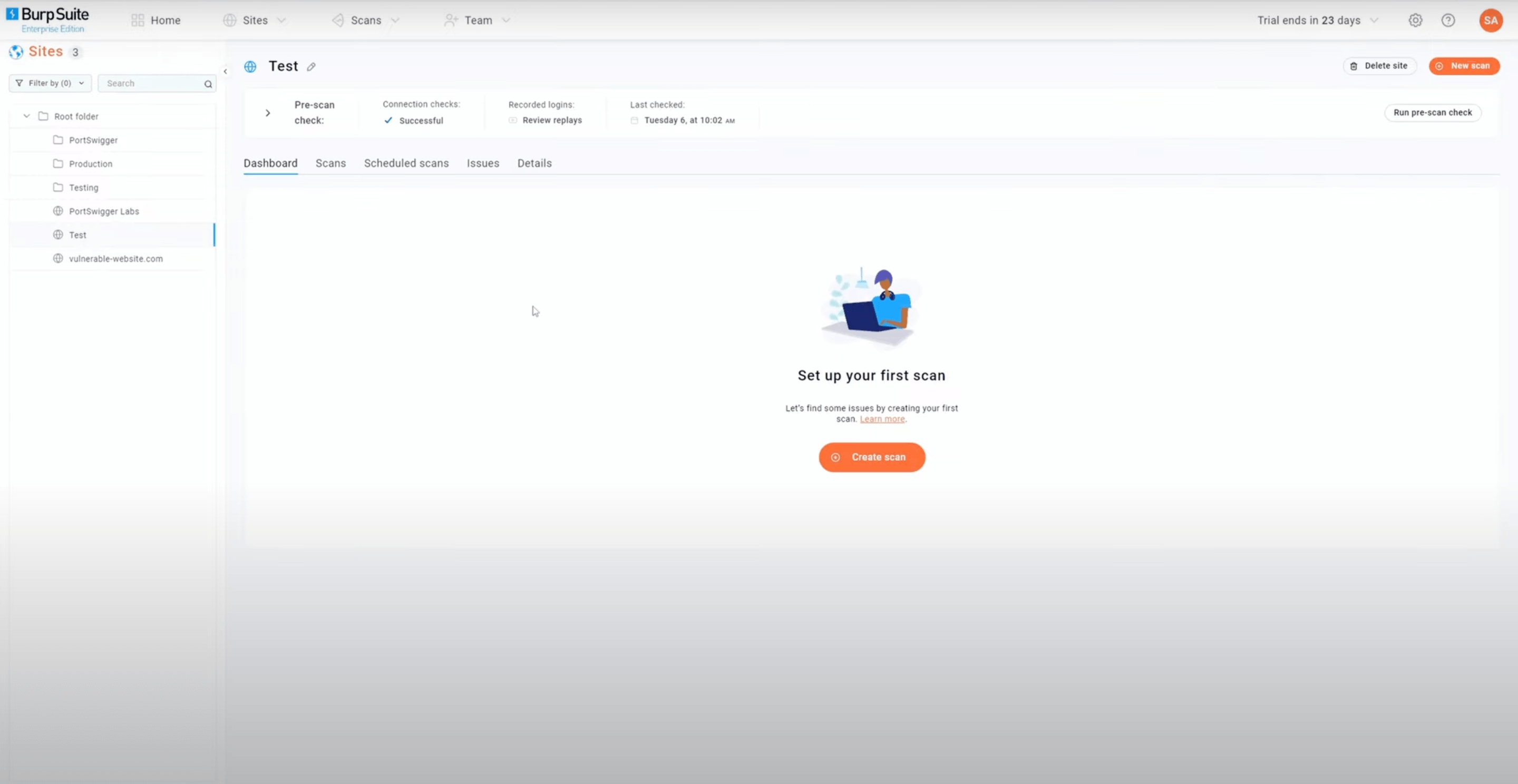
Without specialized support for application discovery, Burp Suite DAST does not provide the same level of visibility and proactive detection as Escape, potentially leaving organizations vulnerable to undiscovered exposed, and especially API-related, vulnerabilities.
Reporting
Escape shines in this aspect with its robust reporting capabilities, offering dashboards, Compliance Matrix, Pentest PDF exports, CSV exports, and developer-friendly exports.
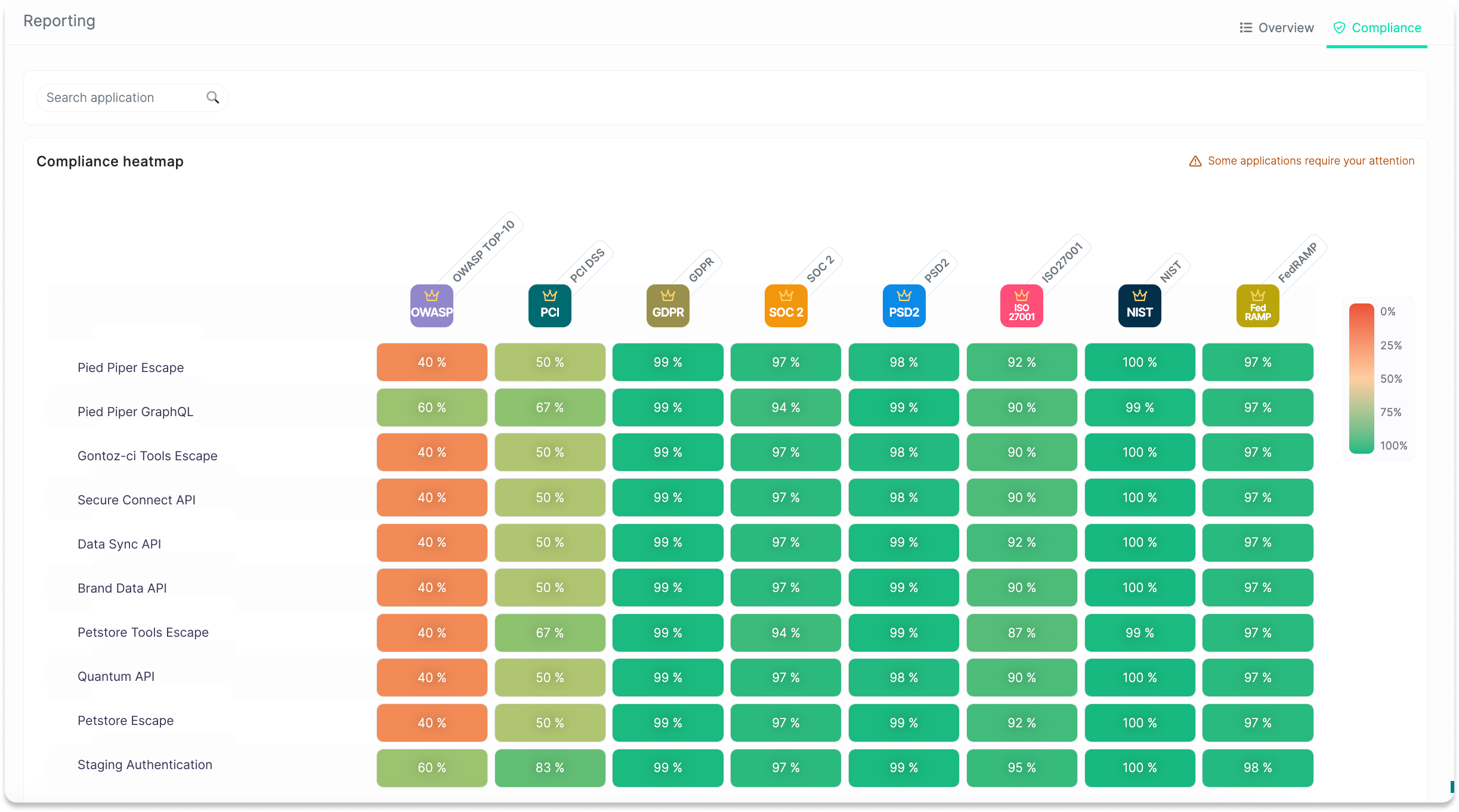
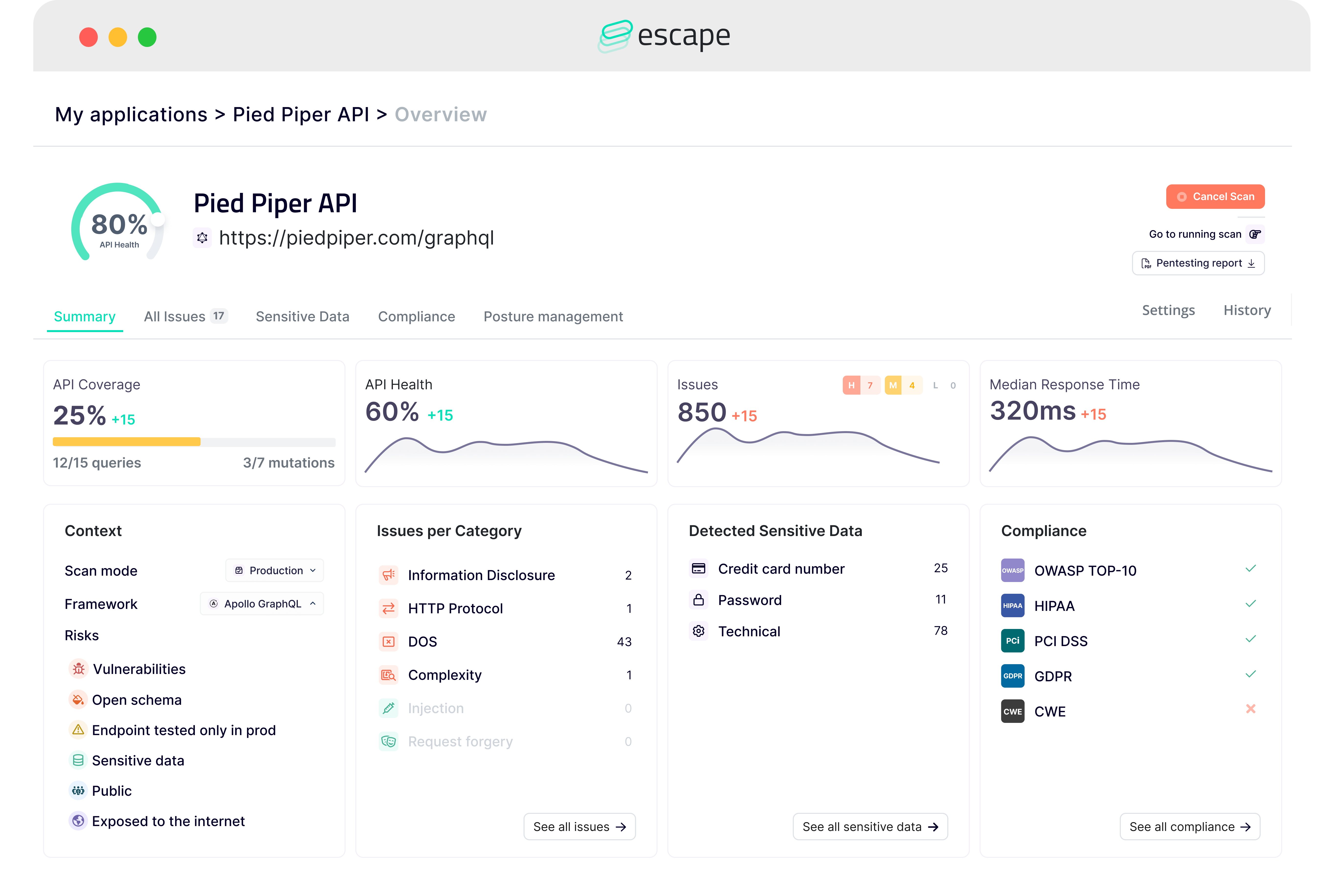
While reporting capabilities are included in Burp Suite DAST, including email reporting, aggregated issue reporting, compliance reporting, and report exporting, they are not as extensive as those offered by Escape and mainly available per dedicated scan only:
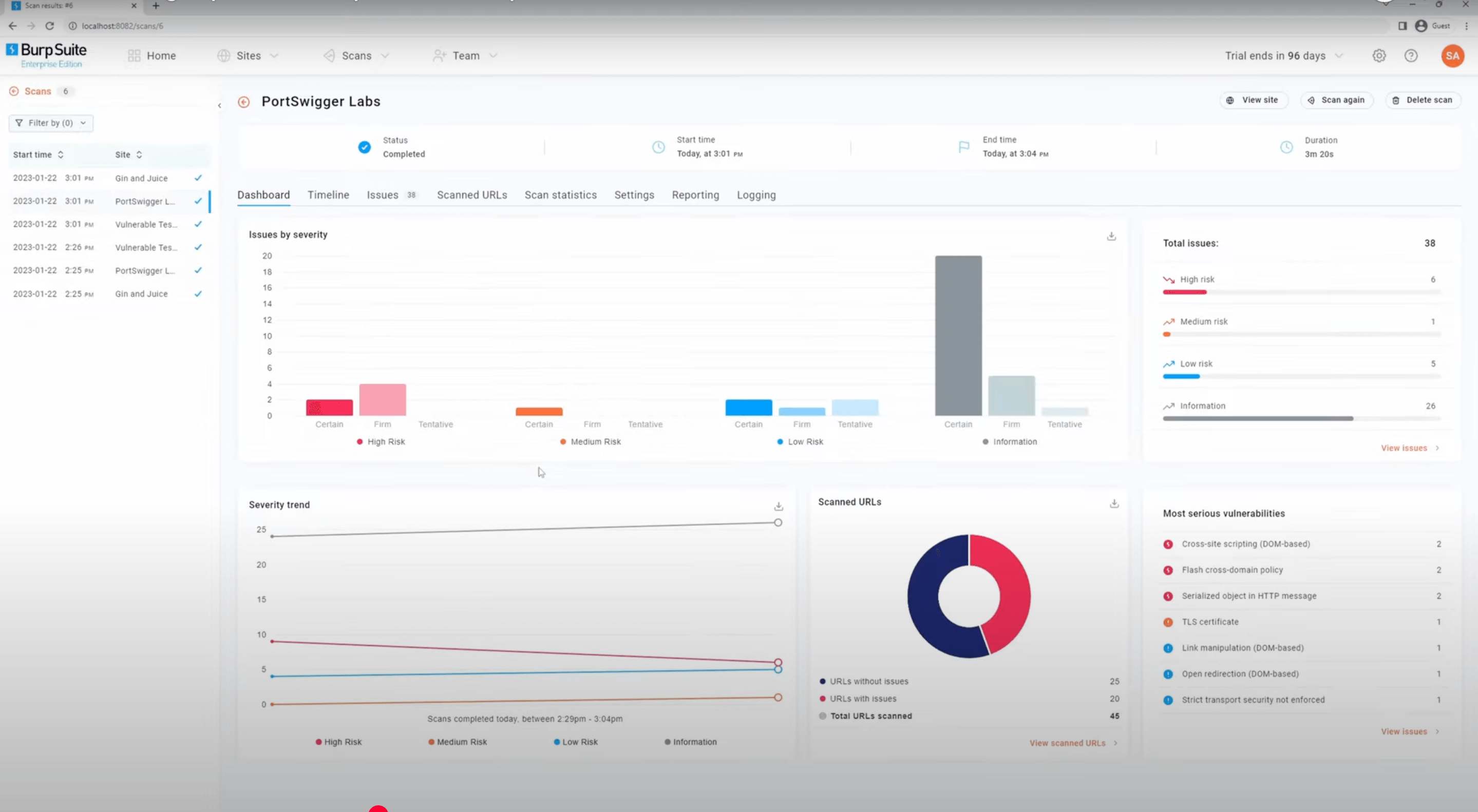
Conclusion: Is Escape a viable alternative to Burp Suite DAST (formerly Burp Suite Enterprise)?
In conclusion, both Escape and Burp Suite DAST (former Burp Suite Enterprise) offer valuable DAST solutions, but Escape emerges as the superior choice for organizations looking for automated business logic security testing, especially for modern web applications and GraphQL APIs.
With its exceptional support for advanced business logic testing, proactive API discovery, seamless CI/CD integration, tailored developer remediations, and extensive reporting capabilities, Escape DAST provides a holistic approach to web application security.
Scale your business logic security testing quickly with Escape DAST. And see how it compares to Burp Suite DAST
Get a demo💡 Want to learn more? Discover the following articles:

